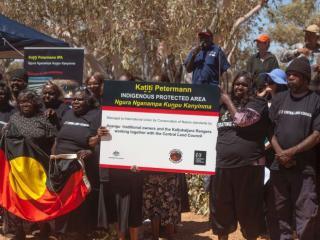
The Katiti-Petermann Indigenous Protected Area (IPA) was dedicated in 2015. It is managed by the Central Land Council's Kaltukatjara Rangers and Mutijulu Tjakura Rangers. This IPA spans five million hectares. This means one dozen Aboriginal rangers manage an area of Aboriginal freehold land larger than Switzerland.
Katit-Petermann IPA surrounds and dwarfs the Uluru-Kata Tjuta National Park. It is part of a vast network of protected areas straddling the borders of the Northern Territory, Western Australia and South Australia. Numerous Dreaming lines crisscross the IPA. It also shelters many sites of cultural importance to its Anangu traditional owners. The Katit-Petermann IPA supports diverse plant and animal communities, including threatened species such as the tjakura (great desert skink), murtja (brush-tailed mulgara) and warru (black-footed rock wallaby).
The Mutitjulu-based Tjakura Rangers joined the Kaltukatjara Rangers from Docker River in 2018. The two groups plan and implement Anangu cultural and natural resource management priorities for the IPA. They carry out collaborative surveys using traditional tracking skills and the cutting-edge Tracks app. With these tools they monitor significant plants and animals, and inform conservation initiatives.
During the cool time, the rangers take part in cross-border fire management. The aim is to reduce the impact and frequency of devastating summer wildfires. It is undertaken through traditional patchwork and aerial burning.
They also cull feral camels as part of the Australian Feral Camel Management project. This project has seen tens of thousands of camels removed from the IPA and important waterholes protected.
The rangers go with their Elders on visits to important cultural sites. Here, young Anangu learn about Tjukurpa (Dreaming) and site protection. They also maintain facilities along the Tjukaruru Road, a section of the Outback Way.
Increasing tourism numbers at Kaltukatjara campground, Tjunti (Lasseter's Cave) and fledgling Aboriginal tourism initiatives pose new challenges for the ranger groups. These challenges include unregulated camping and the destructive spread of buffel grass.
State: NT - Central Australian region
Administration Organisation
Central Land Council